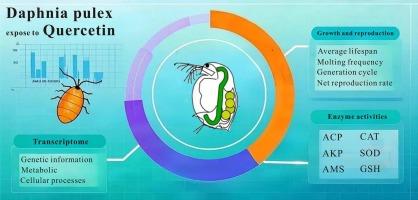Quercetin enhances antioxidant capacity and reproductive performance in daphnia pulex
IF 2.2
2区 生物学
Q4 BIOCHEMISTRY & MOLECULAR BIOLOGY
Comparative Biochemistry and Physiology D-Genomics & Proteomics
Pub Date : 2025-08-25
DOI:10.1016/j.cbd.2025.101625
引用次数: 0
Abstract
Quercetin is a widely distributed flavonoid found in fruits and vegetables, known for its diverse biological effects. In this study, neonatal Daphnia pulex (within 24 h of birth) were exposed to varying concentrations of quercetin (0, 1, 2.5, 5, and 10 mg/L). At high concentrations, quercetin induced morphological deformities, including concavity on the dorsal surface, which appeared earlier in treated individuals compared to controls. Conversely, low concentrations of quercetin extended the average lifespan, increased molting frequency, and significantly enhanced the net reproduction rate and generation cycle. In contrast, high concentrations significantly reduced both molting frequency and net reproduction rate. Regarding metabolic and antioxidant enzyme activities, quercetin exposure decreased triglyceride (TG) levels. Low concentrations significantly downregulated the activities of acid phosphatase (ACP) and alkaline phosphatase (AKP), while all tested concentrations significantly reduced amylase (AMS) activity. Catalase (CAT) and glutathione (GSH) levels initially increased and then declined with rising quercetin concentrations, a pattern also observed for superoxide dismutase (SOD) activity after 14 days of exposure. Transcriptomic analysis revealed that quercetin treatment significantly upregulated metabolic pathways, followed by cellular processes and genetic information processing. Additionally, quercetin enhanced oxidative phosphorylation and alleviated oxidative stress. These findings suggest that low concentrations of quercetin promote the growth and reproduction of D. pulex, regulates metabolic activity, and enhances antioxidant capacity.

槲皮素提高水蚤抗氧化能力和繁殖性能
槲皮素是一种广泛存在于水果和蔬菜中的类黄酮,具有多种生物效应。在这项研究中,新生儿水蚤(出生24小时内)暴露于不同浓度的槲皮素(0、1、2.5、5和10 mg/L)。在高浓度下,槲皮素诱导的形态畸形,包括背部表面的凹陷,在治疗个体中比对照组出现得更早。相反,低浓度槲皮素延长了平均寿命,增加了换羽频率,显著提高了净繁殖率和世代周期。相反,高浓度显著降低换羽频率和净繁殖率。在代谢和抗氧化酶活性方面,槲皮素暴露降低了甘油三酯(TG)水平。低浓度显著下调酸性磷酸酶(ACP)和碱性磷酸酶(AKP)活性,而所有浓度均显著降低淀粉酶(AMS)活性。随着槲皮素浓度的升高,过氧化氢酶(CAT)和谷胱甘肽(GSH)水平先升高后下降,暴露14天后超氧化物歧化酶(SOD)活性也出现了这种模式。转录组学分析显示,槲皮素处理显著上调了代谢途径,随后是细胞过程和遗传信息处理。槲皮素还能增强氧化磷酸化,减轻氧化应激。上述结果提示,低浓度槲皮素可促进黄颡鱼的生长和繁殖,调节代谢活性,增强抗氧化能力。
本文章由计算机程序翻译,如有差异,请以英文原文为准。
求助全文
约1分钟内获得全文
求助全文
来源期刊
CiteScore
5.10
自引率
3.30%
发文量
69
审稿时长
33 days
期刊介绍:
Comparative Biochemistry & Physiology (CBP) publishes papers in comparative, environmental and evolutionary physiology.
Part D: Genomics and Proteomics (CBPD), focuses on “omics” approaches to physiology, including comparative and functional genomics, metagenomics, transcriptomics, proteomics, metabolomics, and lipidomics. Most studies employ “omics” and/or system biology to test specific hypotheses about molecular and biochemical mechanisms underlying physiological responses to the environment. We encourage papers that address fundamental questions in comparative physiology and biochemistry rather than studies with a focus that is purely technical, methodological or descriptive in nature.

 求助内容:
求助内容: 应助结果提醒方式:
应助结果提醒方式:


